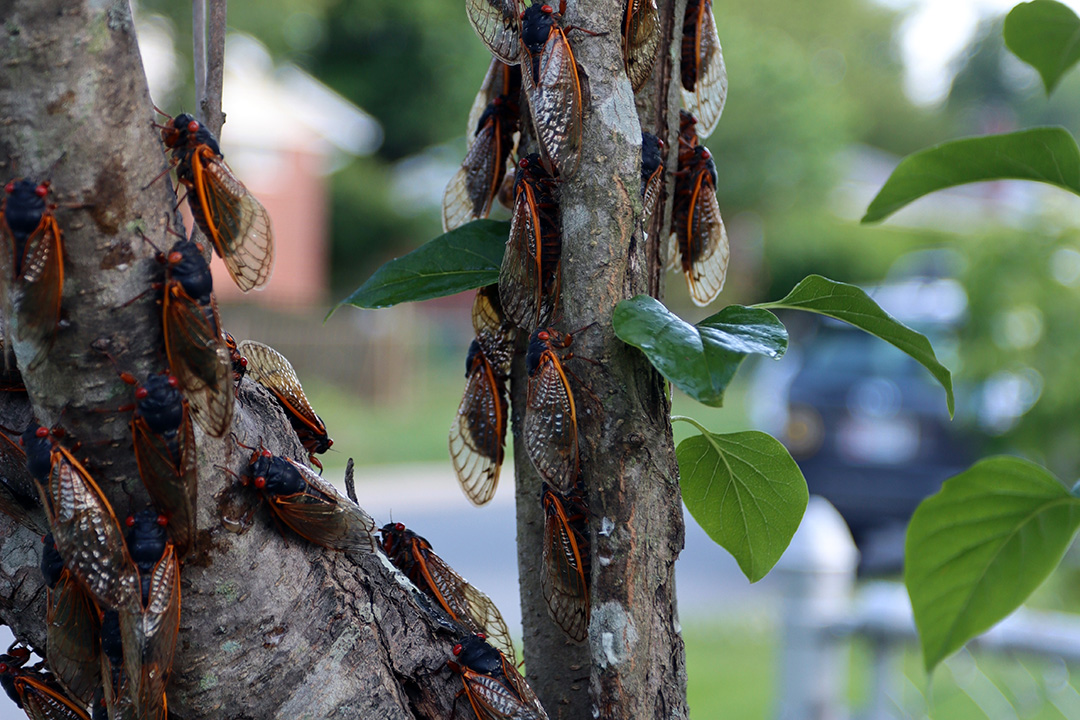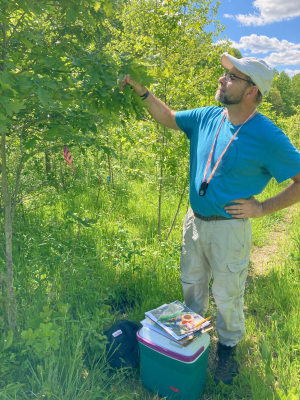Authored by: John DiConsiglio
If insects bug you, avoid the Midwest for a few weeks. That’s the site of the latest Cicadapocalypse—a historic cicada emergence underway across 17 states.
While much of the Eastern United States experiences periodic cicada emergences every 13 or 17 years, two broods are co-emerging in a region that stretches from southern Maryland to eastern Wisconsin.
The two broods—the 13-year cicadas known as Brood XIX and the 17-year Brood XIII— haven’t emerged together since 1803, when President Thomas Jefferson was completing the Louisiana Purchase.
From late April through June, wooded and suburban areas in the Midwest will buzz with the distinctive chirps of trillions of cicadas as they mate, lay eggs and die off before their hatchlings burrow back underground and start the cycle again. Cicada veterans know that the insects can be annoying, but they aren’t harmful to people or pets.
Professor of Biology John Lill spoke to GW Today from Illinois—the epicenter of the 200-year phenomenon—where he had a front row seat to Cicadapalooza.
Q: For those of us who thought we could take a break from cicadas after the latest emergence in 2021, can you explain what’s happening now? Why are they back? And what makes this emergence so special?
A: Well, in the Washington, D.C., area, you’re probably safe until about 2038. But the reason the cicadas are getting so much attention now is because there are two emergences happening simultaneously in the Midwest—a 13- and a 17-year brood.
This 13-year brood—Brood XIX, which is often called the “Great Southern Brood”—is the largest of the three broods of 13-year cicadas. It goes all the way from southern Illinois through Missouri, Arkansas, Tennessee and parts of Kentucky. And then it heads south through parts of Louisiana, Alabama, Mississippi, Georgia, the Carolinas and up into the middle of Virginia.
It’s emerging at the same time as the northern Brood XIII, a 17-year brood. They overlap mostly in central Illinois. That’s why I’m here. The whole state of Illinois, pretty much top-to-bottom, is covered in cicadas right now.
Q: Why is this happening? Is it just a coincidence of the calendar?
A: It’s not a coincidence. In fact, it’s very scheduled. You could have predicted this convergence was going to happen 221 years ago—the last time these two broods emerged together. It’s literally just basic math. The product of 17 and 13 is 221. So it happens every 221 years. That’s how methodical and predictable these mass emergencies are.
Q: Can you give us a brief refresher on why cicadas periodically emerge in these large broods after long intervals?
Emerging en masse in irregular intervals is sort of a strategy to completely overwhelm their potential predators.
Cicadas don’t have any natural defenses. They don’t have any chemical defenses or physical defenses. They’re not cryptically colored. They’re actually quite brightly colored, with their orange and black wings and red eyes. But they survive and reproduce, billions and billions of them each time despite massive amounts of consumption by all kinds of consumers—birds, ants, raccoons, possums, fish, literally anything that can eat them.
So they have evolved a phenomenon known as predator satiation. By their sheer numbers, they can gain a reproductive advantage over their potential predators. The long time between emergences is important because if they emerged, say, every three years, then their predators could potentially anticipate them.
But those 13- and 17-year stretches are beyond the lifespans of most of the consumers that regularly eat them. Each time an emergence happens, it’s brand new to those consumers. They’re experiencing these insects for the first time. They have to figure out what these things are; how to catch them; how to eat them. It’s a learning process that happens every single time. And for the cicadas, it always seems to work.
Q: You’re in Illinois—ground zero for Cicadageddon. What does it look like?
A: The confluence is just south of where I am in Chicago. The two broods’ geography more or less overlaps in the Urbana-Champaign area. If you’re into it, you can conceivably collect all seven existing cicada species in that one small area within these two broods.
But to be honest, if you didn’t know this convergence was happening, you could drive through it and not even notice.
There were a lot of misconceptions that the skies would be black with cicadas. But in any one place, you’re probably only going to get one brood—so you won’t see twice as many cicadas. The convergence is mostly interesting because it covers such a large swath of real estate.
This particular co-emergence has not happened in a long time, but there are other 13- and 17-year cicadas that emerge together. There were at least two in the last decade, but they were geographically separated.
So I think the convergence in both space and time has caused a lot of excitement and made it enthralling for so many people.
Q: Is it a more significant event for scientists?
A: For evolutionary biologists, this event is very exciting. It provides a rare opportunity to observe these species seeing each other for the first time in a really long time. They’re interested to see if, in this overlap zone, [the cicadas] encounter one another and whether there could be potential hybridization between these close species relatives.
I’m focused on uncovering the ecological consequences of these mass emergences. The cicadas provide a massive input of food. During these emergences, animals suddenly switch over to eating cicadas instead of their typical prey—which then get a temporary respite from their predators.
We focused our previous work on the consequences to forest ecosystems when birds start eating cicadas instead of caterpillars. The other major consumer in these forests—which actually outnumber birds in terms of both abundance and definitely in terms of biomass—are ants.
Cicadas are rich in fat and protein, which is a prized resource for foraging ants. When this food pulse happens, ants likely switch their feeding habits. The cicada emergence provides a sudden surplus of protein and fat to an entire community of ants. We’re interested in how that changes their foraging dynamics and how some of the ecosystem functions that ants provide might be disrupted during cicada emergences.
So the rippling effects of these emergences spread out in both in space and time and may potentially persist for years to come—even after the cicada emergences are over.




